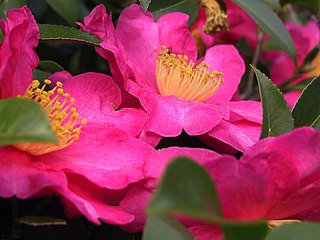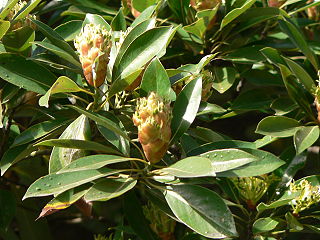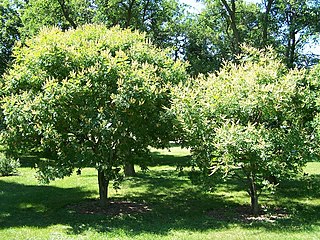
Camellia is a genus of flowering plants in the family Theaceae. They are found in eastern and southern Asia, from the Himalayas east to Japan and Indonesia. There are 100–300 described species, with some controversy over the exact number. There are also around 3,000 hybrids. The genus was named by Linnaeus after the Jesuit botanist Georg Joseph Kamel, who worked in the Philippines and described a species of camellia.

Tilia is a genus of about 30 species of trees or bushes, native throughout most of the temperate Northern Hemisphere. The tree is known as linden for the European species, and basswood for North American species. In Britain and Ireland they are commonly called lime trees, although they are not related to the citrus lime. The genus occurs in Europe and eastern North America, but the greatest species diversity is found in Asia. Under the Cronquist classification system, this genus was placed in the family Tiliaceae, but genetic research summarised by the Angiosperm Phylogeny Group has resulted in the incorporation of this genus, and of most of the previous family, into the Malvaceae.

Tetradium is a genus of trees in the family Rutaceae, occurring in temperate to tropical east Asia. In older books, the genus was often included in the related genus Euodia, but that genus is now restricted to tropical species. In cultivation in English-speaking countries, they are known as Euodia, Evodia, or Bee bee tree.

Stewartia is a genus of 8-20 species of flowering plants in the family Theaceae, related to Camellia. Most of the species are native to eastern Asia in China, Japan, Korea, Laos, Myanmar, Thailand, and Vietnam, with two in southeast North America, from Virginia and Kentucky south to Florida and Louisiana.

Machilus is a genus of flowering plants in the family Lauraceae. It is found in temperate, subtropical, and tropical forest, occurring in China, Korea, Japan, Taiwan, Vietnam, Laos, Cambodia, Indonesia, Borneo, and the Philippines. It is sometimes included in the genus Persea, and currently includes about 100 species.

Tilioideae is a flowering plant subfamily in the family Malvaceae, though it was formerly considered a large group, placed at family rank and called Tiliaceae.

Maackia is a genus of flowering plants in the legume family, Fabaceae. There are about 12 species, all native to eastern Asia, with six endemic to China. The generic name honors the botanist Richard Maack.
Pyrenaria is a genus of flowering plants in the family Theaceae.

Schima is a genus of evergreen trees belonging to the tea family, Theaceae.

The Taiwanese rock scene is nurtured by regular festivals, notably the annual Spring Scream, Hohaiyan and Formoz festivals.

Tiger Cage 2 is a 1990 Hong Kong action film directed by Yuen Woo-ping and starring Donnie Yen. The film is a sequel to the 1988 film Tiger Cage, which was also directed by Yuen, and features a new storyline with returning cast members Yen and Carol Cheng in different roles.

The Heaven Sword and Dragon Saber is a Taiwanese television series adapted from Louis Cha's novel of the same title. The series was first broadcast on TTV in Taiwan in October 1984.

Hanosaurus is an extinct genus of marine reptiles that existed during the Triassic period in what is now China. It was described by Young in 1972, and the type species is Hanosaurus hupehensis. Its affinities are unclear; it has been both described as a member of the Pachypleurosauria and as a sister group of that group. It was a small animal that likely fed on soft-bodied prey.
Lin Hung-yu is a Taiwanese baseball player for the Rakuten Monkeys of the Chinese Professional Baseball League (CPBL).

Man Wanted is a 1995 Hong Kong action thriller film directed by Benny Chan and Steve Cheng and starring Simon Yam, Yu Rongguang, Christy Chung and Eileen Tung.

Chinese Taipei competed at the 1994 Asian Games in Hiroshima, Japan. This was their 6th appearance in the Asian Games. They won at total of 7 gold, 13 silver, and 24 bronze medals, or 44 medals in total. They improved from the previous Asian Games in 1990, where they won a total of 31 medals. They won the most medals in Judo, where they got a total of 1 silver and 5 bronze.

Chang Chun-yen was a Taiwanese electrical engineer and professor who served as President of National Chiao Tung University (NCTU).

Calycanthus chinensis, known as Chinese sweetshrub, is a species of flowering plant in the family Calycanthaceae, native to Southeast China. It was first given a valid scientific name in 1964. It is cultivated as an ornamental flowering shrub, and has been hybridized with two other species in the genus Calycanthus to combine its larger and broader tepalled flowers with their scented and more colourful ones.
Magnolia fulva is a species of flowering plant in the family Magnoliaceae, native to south-central China and Vietnam. It was first described, as Michelia fulva, in 1987.















